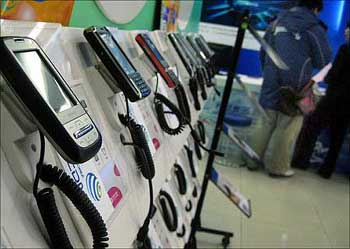 | « Back to article | Print this article |
Idea takes 3G bets on rural market
Idea Cellular has gone off the beaten track in its 3G growth strategy.
While peers like Bharti Airtel, Vodafone and Reliance Communications launched their services in metros before going to smaller towns, Idea is doing exactly the opposite.
It is going to semi-urban and rural subscribers first.
The company believes 3G will become an enabler in smaller towns which do have good broadband access.
Himanshu Kapania, managing director, says metros and urban centres have the advantage of high-speed Internet which is served by fixed line as well as wireless services.
Click NEXT to read further. . .
Idea takes 3G bets on rural market
That's not the case with semi-urban and rural areas.
"Look at towns like Bijnor or even Itchalkaranji. The customers there may not yet be digitally savvy, but they are bandwidth-hungry and have no other option available. Just 5-10 per cent of these customers will be enough to see us through," says Kapania.
Idea says that digitally savvy youth, who looks for applications like faster video streaming and mobile TV is equally present in smaller towns as much as in urban areas. This population, which will be one of the early adopters of 3G service, will be its target consumers.
Analysts too say that there will be early 3G users in non-metros.
"Idea will certainly get a first mover advantage with its strategy. But the real question is how many of these customers will be there beyond metros?
Click NEXT to read further. . .
Idea takes 3G bets on rural market
"Moreover, competition could also launch there, and catch up," says Alok Shende, principal analyst and co-founder, Ascentius Consulting.
Idea plans to start its rollout in professional colleges to target the young student population.
Young professionals are also yet another focus as the company plans to offer these services in industrial zones and belts in A, B and C circles.
Some of the rural areas with strong farming communities and mandis also have active agriculture based trading.
"In these places, we already have a huge uptake of 2G business on the data side," says Kapania.
The company's overall average revenue per user is Rs 200.
In the towns where it is present, the top 20 per cent of the customers give them around three-four times the average revenues.
Click NEXT to read further. . .
Idea takes 3G bets on rural market
"To state that these kind of ARPUs happen only in metros is not factually correct. As the country's gross domestic product grows, the participation of these customers in mid-sized towns will go up.
"And there is an income category in these towns which is currently spending four to five times the average ARPU on both voice and text," says Kapania.
To aid 3G users, who might not be well versed with data usage, the operator has come up with time-based tariff plans.
As a general rule, data is billed on usage basis, but the data plans follow the pulse.
For example it is billed based on time spent on the Internet as opposed to 'download based' plans by everyone else.
Click NEXT to read further. . .
Idea takes 3G bets on rural market
Time-based billing by the company is however an extra offering, as it also has download-based plans for the more discerning customer.
Idea may find the going relatively easy.
The company, which has presence in 300,000 villages, has the highest share of rural subscribers as a percentage of total subscribers, amongst GSM operators.
And two out of every three new subscribers now come from non-urban markets.
Idea Cellular has 3G services in 11 smaller circles, which contribute 81 per cent of its total revenues.
The company's internal research shows that almost 10 per cent of these customers already own 3G handsets.
These markets are also showing early uptake of tablet PCs and medium-sized smartphones.





